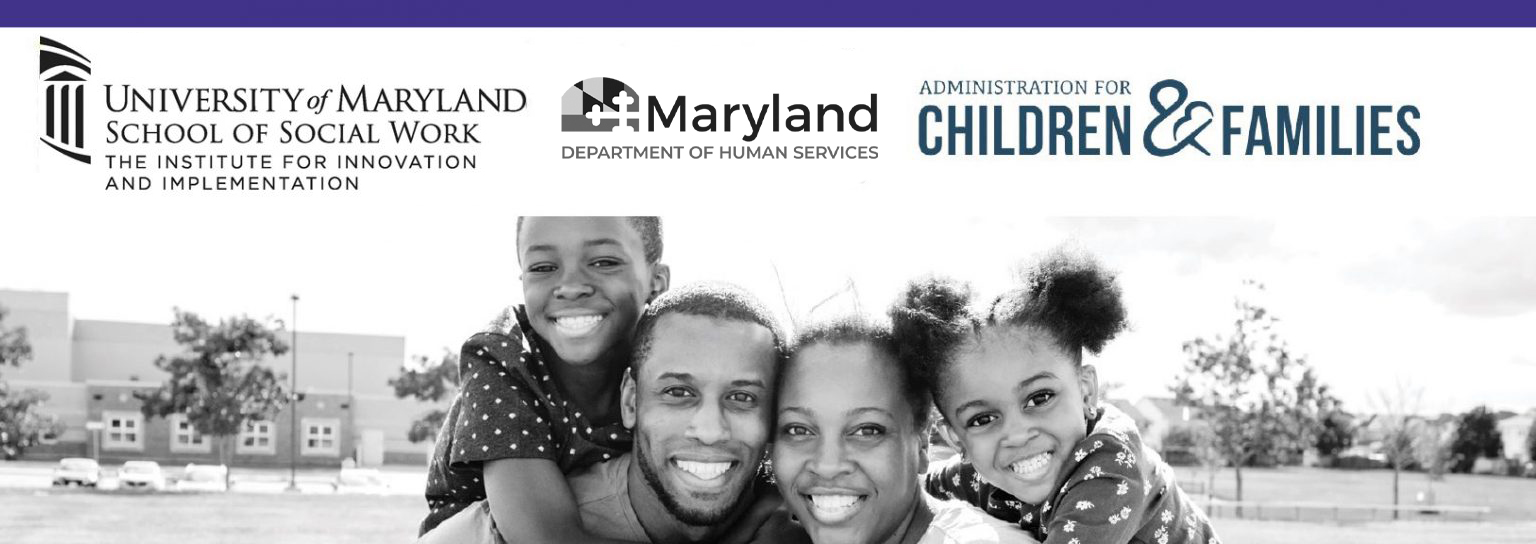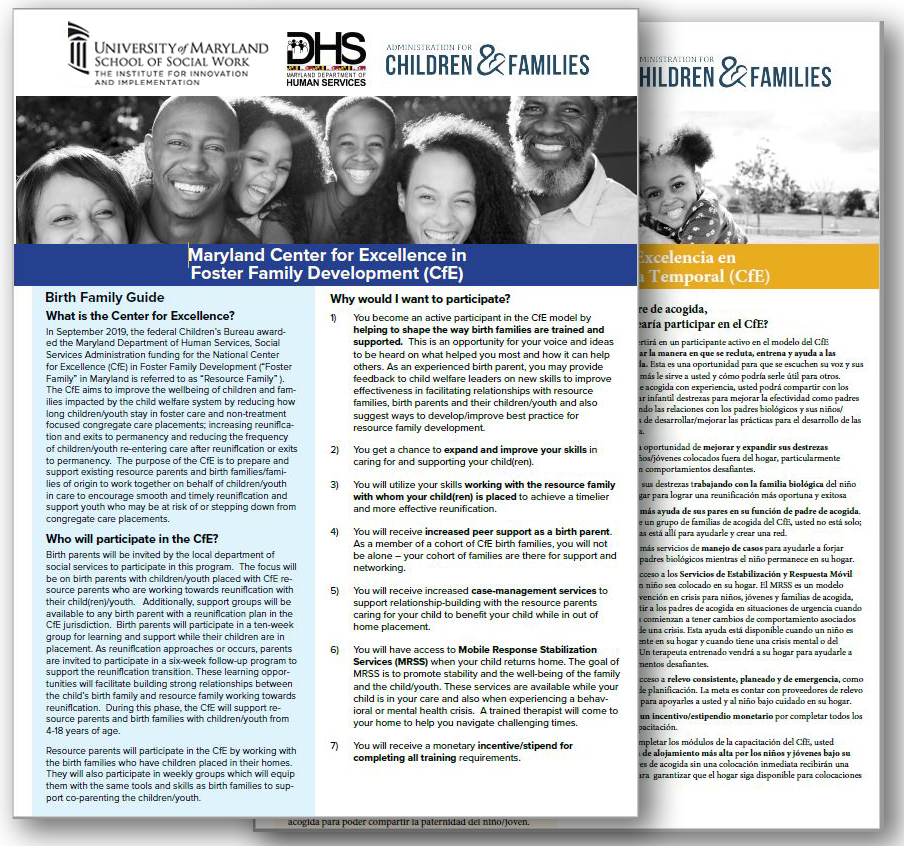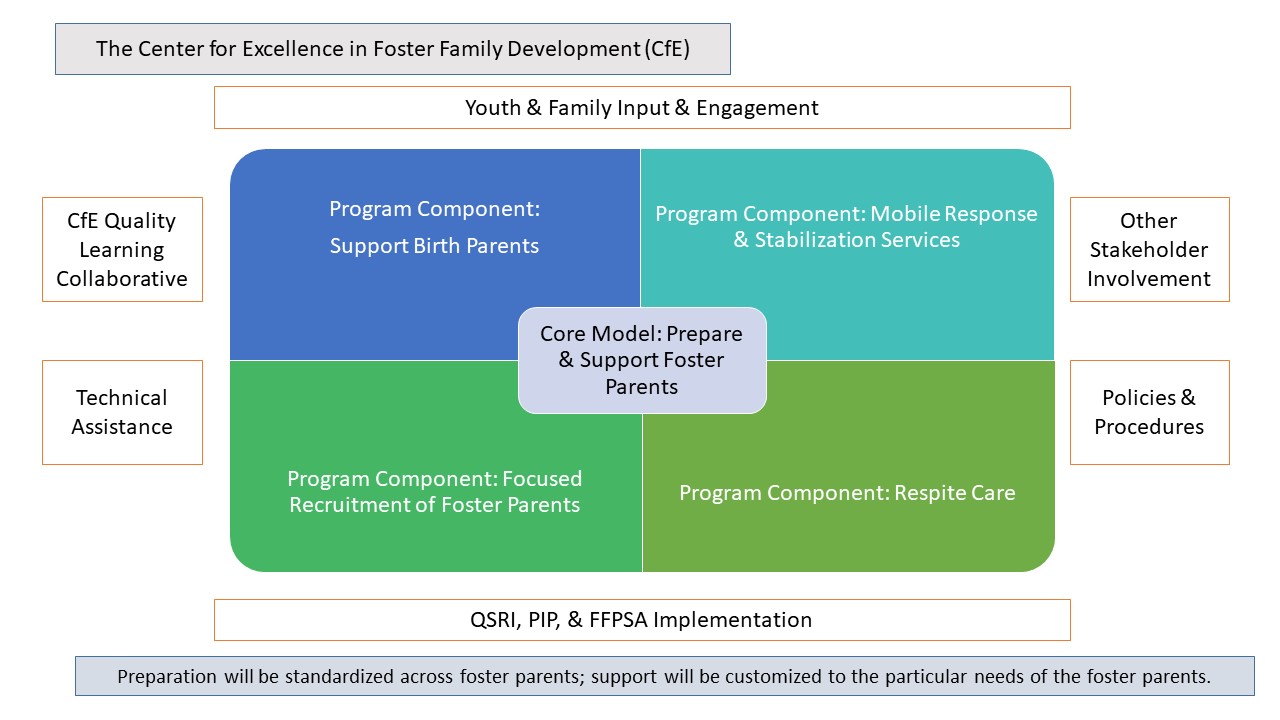Center for Excellence in Resource Family Development (CfE)

The federal government- HHS Children’s Bureau – has awarded Maryland DHS with a four-year grant to create a Center of Excellence for Foster Family Development – the only one of this grant awarded in the country. The Center for Excellence will develop and implement a model to guide local and state partners to recruit, prepare and support new and existing resource families resulting in:
- Improved engagement, development, and support of resource families;
- Improved retention rates and relationships with resource families;
- Increased number of resource families prepared to provide enhanced supports to children and their families towards reunification;
- Development of resource families in the neighborhoods and communities children in foster care most come from;
- Reduced inappropriate use of congregate care placements
- Comprehensive biological family support services and timely, stable reunification; and
- Improved permanence stability, family and community connections, and well-being outcomes for children placed with resource families in the target group.
Maryland Center for Excellence in Resource Family Development (CFE)
What’s in it for Resource Parents
Resource parents who participate in this exciting venture will be selected by their local department of social services. Over the course of their involvement, they will participate in additional training to address the needs of the children and youth placed in their home, will participate in groups for additional learning and support, and will be encouraged and helped to build strong relationships with the child’s birth family.
Benefits for Participating Resource Parents
Why Would a Resource Parent Want to Participate?
- This is a collaboration between the federal and Maryland’s agencies responsible for child welfare to identify effective and innovative strategies to recruit, prepare and support resource parents. You get to participate in, and help shape, and change the way resource families are recruited, trained and supported. Not only will your voice and ideas be heard, you will provide feedback on what helped you most and how it can help others. You can provide feedback to child welfare leaders on what new skills need to be taught in order to improve effectiveness as a resource parent, share your experiences working with birth parents and suggest ways to improve upon the model of practice we are developing.
- You get a chance to expand and improve your skills in working with children and youth in out of home placement, particularly those demonstrating challenging behaviors, and their birth families. You will gain skills and opportunities for working with the birth family of the child(ren) placed in your home including new ways of working more closely with birth parents toward the more timely and effective reunification.
- You will experience increased support in your role as resource parent. Being part of a cohort of resource families who are participating in the CFE provides planned, and unplanned, peer support. You will not be alone – your cohort of families is there for support.
- You will also receive increased case management support and community connections via the social worker assigned to work with you.
- You will have access to mobile response and stabilization support for when a child placed with you is experiencing a mental health crisis. A therapist, specially trained to assist you, will come to your home to help you navigate these most challenging times.
- You will have access to respite as part of the case plan, and on a consistent, planned basis. The goal is to consistently have the same respite provider for the child in your home. Respite for emergency situations will also be available.
- You will be compensated for your time in training as well as the additional support you will provide to the youth and the youth’s parents. You will be compensated for days when you hold a bed for a youth enrolled in the CfE.
Center for Excellence for Foster Family Development
What’s in it for DSS?
Internal Promotion (LDSS selected sites)
- Placement stability and enhanced relationship with birth/family of origin
- Technical Assistance directly from Model purveyor
- Robust foster parent training program
- Community Support Services
- Improvement to Maryland’s foster care system
External Promotion (Child Welfare States)
- Nationwide recognition for resource home development
- Improvement to foster care system
- Packaged model to replicate
- Published outcome measures

In September 2019, the federal Children’s Bureau awarded the Maryland Department of Human Services (DHS)/ Social Services Administration (SSA) funding for the National Center for Excellence in Foster Family Development (CfE). The purpose of the CfE is to prepare and support resource parents to support timely reunification, permanency, & family-based placements. The CfE is the mechanism to develop and implement a model for resource parents to work in close collaboration with birth families to preserve and nurture critical parent-child relationships and support reunification. Resource parents participating in the program will provide enhanced reunification and stability support to birth families and children.
The CfE believes that, by increasing the number of available resource parents who are adequately prepared and trained to serve children and youth in care and build relationships with birth parents, as appropriate, fewer children and youth will be placed in unnecessary congregate care settings and age out of care without permanency. By preparing resource parents to co-parent with and mentor birth families more children and youth will be able to safely reunify and will experience shorter stays in care, thereby reducing the trauma of caregiver separation, and potential for additional placements and lack of permanent connections. Finally, facilitated peer-to-peer support is provided to birth parents to help address their needs and those of their children in order to ensure successful and lasting reunification.
A priority for the CfE was programming that supported resource parents to serve as mentors or co-parents with the birth families of children and youth in their care. To meet these criteria, the CfE sought programming that provided birth families with the same information, skills and strategies as the resource parents to allow for cohesive co-parenting and smooth transitions for children and youth upon reunification. Together the KEEP/ KEEP Safe and PTC-R interventions will provide resource parents and birth parents a common set of skills to support youth’s needs, using consistent parenting strategies in resource homes and with birth families. It will provide an opportunity for the resource parents to provide support to the birth families as they build these skills in anticipation of reunification with their child.
KEEP and PTC-R were successfully implemented in unison in New York City. Both models are grounded in the same theoretical and practical foundation, lending themselves to simultaneous implementation with different populations. This allows both resource parents and birth families to receive the same information and skills-based trainings and support further consistency for the children and youth in their care. Approximately 9 months after training began in New York, evaluators saw a 20% increase in permanent exits from foster care and a 14% decrease in placement moves. These two interventions will provide ongoing, customized support for resource families and birth families. KEEP/KEEP SAFE will be provided to resource parents while PTC-R will be provided to birth families.
KEEP® and KEEP SAFETM have been recognized by several independent clearinghouses and registries for promising and evidence-based practices.
- KEEP: The California Evidence-Based Clearinghouse for Child Welfare; National Institute of Justice – Crime Solutions Clearinghouse
- KEEP SAFE: The California Evidence-Based Clearinghouse for Child Welfare; Blueprints for Healthy Youth Development; National Institute of Justice – Crime Solutions Clearinghouse
Children and adolescents whose caregivers participated in KEEP or KEEP SAFE demonstrated:
- Lower rates of emotional and behavioral problems;
- Shorter lengths of stay in foster care;
- Lower rates of placement disruptions for youth with multiple previous placements;
- More frequent reunification with family; and,
- Less substance use (for adolescents).
The foster and kinship parents who participated in KEEP or KEEP SAFE demonstrated:
- Higher rates of positive parenting and lower rates of discipline;
- Lower rates of turnover;
- Spillover of positive effects to other children in the home; and,
- Fewer placement breakdowns.
Child welfare agencies participating in KEEP or KEEP SAFE experienced
- Longer tenure for foster parents providing care and
- Fewer days in foster care for children.3
Resource parents will participate in prerequisite training in addition to Maryland’s standard pre-service training and support for resource parents. This training will provide resource parents a better understanding of how parent partnership supports successful reunification and promotes child well-being; strategies and skills for building a birth parent partnership, including making the most of visitation. It will address how to support youth and practice self-care through the reunification process. The proposed training modules draw from existing training curricula developed by training professionals within the University of Maryland, School of Social Work and their training partners. The training will be delivered by training professionals, including former resource parents. There may be opportunities to invite birth families to co-train with resource parents. This is an area of innovation to be tested through the CfE.
Resource parents will also participate in KEEP (Keeping Foster and Kin Parents Supported and Trained) a 16-week evidence-based support and skill enhancement program for resource parents of children ages 4-12. The adaptation, KEEP SAFE, is for resource parents caring for youth ages 10-18. KEEP has been demonstrated to contribute to shorter lengths of stay in care, lower rates of emotional and behavioral challenges in children and youth, more frequent reunification with families of origin, fewer placement disruptions, and lower rates of turnover in both foster and kinship parents. The effects for preventing disruption were strongest for children who had been placed in multiple previous foster homes.1
Caregivers who participate in KEEP learn to reinforce normative & prosocial behavior, build cooperation, teach new behaviors, use non-harsh effective limit-setting, manage emotions while parenting2. Resource parents attend weekly support and training group sessions conducted by two trained facilitators. Between sessions, resource parents have homework assignments to enable them to practice the skills they learned. Facilitators call the resource parents weekly to work through any challenges they are having and to conduct the Parent Daily Report Checklist to prepare for the following session.
Resource parents enrolled in the CfE will receive both a board rate and a treatment foster care difficulty of care stipend.
Mobile Response and Stabilization Services (MRSS) is a program component of the CfE, critical to normalizing challenging behaviors and experiences for both the child and the resource parent upon initial placement in the resource home as well as in response to challenging situations while the child is in foster care. MRSS is a cost effective intervention to safely reduce hospitalizations and placement disruptions.4 The CfE’s MRSS approach will be based on New Jersey’s MRSS model. In New Jersey, from 2014-2017, 95-98% of all children served by MRSS remained in their current living situation (Casey Family Programs, 2018). MRSS will be a standard service that is provided to each child when they enter a new CfE resource home and available on-call within 1 hour to support the child and family and prevent and respond to crises. DHS will be issuing a request for proposals for MRSS providers; the contract could be with one provider or multiple providers, depending on capacity to serve the sites.
Sites participating in the CfE will also be expected to provide planned, quality respite for resource parents, and will be expected to have a pool of respite providers. A recent study of child welfare agencies around the US found considerable variability in the provision of respite care, including how it is accessed, how much is available, and how it is reimbursed. Two of the most significant challenges identified were sufficient financial resources and availability of respite care providers, despite numerous studies demonstrating the benefit of planned respite care to reduce stress and enhance stability.5 The CfE will work with the selected sites to identify current or new resource families who live within a geographic radius that allows resource parents to establish a community of support for each other, facilitating stability and youth well-being, as well as resource parent well-being and retention. The CfE will work with the sites to identify a process for ensuring availability of the respite providers and appropriate and consistent reimbursement.

CfE resource families will understand they are expected to actively work to establish and maintain positive and supportive relationships with birth parents and extended family members and to help build birth parent capacities to care for their children in safe and healthy ways. Resource parents will have a clear understanding that they are expected to invite birth parents into their home on a regular basis and stay in regular communication with the birth parent to ensure he/she/they remain aware of the daily health, well-being and emotional status of their child; and, commit to co-parenting with the birth parents. DHS/SSA expects that the level of care provided to children and their birth parents will help stabilize placements, mitigating the need for congregate care placement and its associated trauma and isolation, and will encourage and support timely reunification.
Sites selected to participate in the CfE will be expected to utilize existing resource parents to build their CfE pool of resource parents. CfE resource parents must be committed to the values and expectations of the CfE, including the prioritization of reunification, shared parenting, and a commitment to the safety, permanency, and well-being of the children. Resource parents will work closely with birth parents and must be able and willing to engage authentically and respectfully with birth families, recognizing them as experts on themselves and their children. Resource parents will be trauma-responsive and practice cultural humility.
As the CfE work expands, sites may need to use targeted recruitment practices to engage additional resource parents. Recruitment activities will include a statewide marketing campaign; data-informed recruitment strategies utilizing the new Child Welfare Information Systems, CJAMS; and, a centralized virtual recruitment, application, and communication hub for current and prospective resource families. The strategies employed by the CfE will reflect current best practices regarding recruitment, preparation, and support for resource families to promote retention and quality practice. In addition to engaging families to serve as CfE resource families, by the end of the cooperative agreement, DHS will engage in recruitment efforts in the areas of the state where the highest number of removals occur. By utilizing geographic data to strengthen local recruitment strategies, children and youth who are removed from their homes are more likely able to remain in their communities of origin, encouraging school stability and other forms of normalcy when they enter out of home placement.
LDSS were invited to apply to the CfE through a standardized application that assessed readiness and capacity for implementing the model, which was then rated on a set rubric. Follow-up phone interviews were held with local departments to gain further insight into their understanding of the CfE and what support they might need to be successful. Other considerations for the site selection included a review of the jurisdictions’ foster care entry rates; resource parent recruitment and retention plans and outcomes; existing programs and initiatives aimed at family preservation, reunification, and engagement; partnerships and collaborations with systems of care supports that could expedite timely access of community services; and diversity (geographic, ethnic, socio-economic) of the jurisdiction. DHS is committed to ensuring that the local sites selected have high percentages of children in congregate care settings; will engage and develop resource families in the neighborhoods and communities that the children come from; and, have the capacity to integrate this program with their existing policies, programs, and initiatives related to recruitment, retention, development, and support of resource families at the local and system levels. The local sites were required to commit to providing sufficient staff and resources to effectively implement the interventions and participate in the QIC.
DHS/SSA, The Institute, and other key partners will provide ongoing support, guidance and technical assistance (TA) to sites. The CfE will utilize a Quality Improvement Collaborative (QIC) with local sites to facilitate decision-making and learning, and ensure that proposed activities are achieved within the specified timeframes. The sites selected to participate in the CfE will be part of a QIC. QICs are a commonly used model in the field of health care to improve provider practices, disseminate evidence-based practices, and improve patient outcomes (Nadeem, Olin, Hill, Hogwood, & Horwitz, 2013). Although specific practices vary, the core concepts often include in-person learning sessions, plan-do-study-act cycles, multidisciplinary quality improvement (QI) teams, and data collection for QI (Ibid, 2013). The CfE QIC will be informed by the work and strategies of the CB-funded National Quality Improvement Center on Tailored Services, Placement Stability, and Permanency for LGBTQ2S Children and Youth in Foster Care, led by DHS’ implementation partner, The Institute.
The QIC will utilize the online learning management system (LMS) managed by UMB, known as Ideas@TheInstitute, to communicate across sites and with DHS and the Steering Committee. The LMS enables users to share information and resources, attend webinars, post blogs, and connect with each other for support, guidance, and TA. The LMS provides a virtual mechanism for sites to collaborate with each other as well as with other programs and projects that support the work of the CfE. The Advisory Committee and local sites will identify other partners to be invited to utilize the LMS.
The Institute will support the local sites and DHS to collect data on individual and cross site outcomes, ensuring that local sites collect appropriate qualitative and quantitative process and outcome data to meet all evaluation expectations. Data will be shared at least quarterly and at the QIC convenings, which will occur at least twice annually. DHS will continue to track data focusing on the youth in congregate care to ensure that percentages of youth, specifically in the local sites selected for the model, are decreasing. DHS also will continue to track placement stability, resource family approval rates, and resource family retention rates. See evaluation section for more detail. The QIC will support the sites to address disproportionality and disparities by providing resources and technical assistance, encouraging peer-to-peer exchanges of ideas and best practices, and utilizing data to make informed decisions.
DHS/SSA is responsible for ensuring that local sites have completed installation and begun implementation within 90 days of beginning Phase II and for monitoring sites, including ensuring project accountability. DHS will be supported in this work through the ongoing data collection and CQI activities of the QIC and evaluation team as well as the monthly calls between DHS and the local sites.
Strong partnerships are critical for effective and efficient model development, program implementation and evaluation activities. The CfE’s Advisory Committee was established soon after DHS/SSA received the award and has met periodically over the first year to provide input and feedback on the model. The CfE Advisory Committee includes the Maryland Coalition of Families (representing birth families in the state), Maryland Resource Parent Association (representing resource families in the state), the Resource Parent Ombuds, the Capacity Building Center on States (to ensure alignment with other related activities) and technical assistance partners. These partners will remain engaged while additional partners are identified at the local level to support local implementation activities. Additional partners also may be engaged at the state level.
The CfE activities are aligned with the work of the Quality Services Reform Initiative (QSRI), which is working to revise payment structures for residential interventions and right-size Maryland’s system so that children are placed in congregate care settings only when it is in the clinical best interest of the child. Maryland’s multi-faceted efforts to implement the Family First Prevention Services Act (FFPSA) also aligns with the CfE activities, including through a focus on developing more home- and community-based services, expanding Chafee eligibility, and adhering to new Child Care Institution standards. DHS/SSA is also implementing new policy development, review, and training standards; as part of this process, numerous policies are being updated and will be aligned with the values and desired outcomes of the CfE, as well as with the Program Improvement Plan and FFPSA.
At the close of the project, we will report on three main changes to practice as a result of CfE: 1. Service level changes; 2. System level changes; and 3. The impact of CfE efforts on birth families, children/youth, resource families, and the workforce. The evaluation will include a process evaluation, implementation evaluation, and outcome evaluation.
Key indicators of success may include:
- Decrease in youth in congregate care settings for non-treatment related reasons.
- Decrease in youth aging out of care.
- Increase in youth exiting care to reunification.
- Decrease in re-entries to care after reunification.
- Increase in resource families committed to birth parent partnership and teens.
- Decrease in resource family turn-over.
- Decrease in placement disruptions.
- Decrease in disparities seen across all indicators for Black and African American youth and families.
- Decrease length of stays for youth in foster care.

Implementation Flyers
Download a Copy
- Becoming A CfE Resource Parent 12. 03b-21 General.pdf
- Becoming A CfE Resource Parent 12.07.21 General Spanish.pdf
- Birth Family Guide 12.07.21 General Spanish.pdf
- Birth Family Guide 1 2.7.21 General Final Approved.pdf
- Center for Excellence Overview 2022.pdf
- CfE Press Release.pdf
- Promoting Parent Partnership Webinar link.pdf

2https://www.keepfostering.org/wp-content/uploads/2019/10/KEEP-Overview.pdf
3https://www.keepfostering.org/wp-content/uploads/2019/10/KEEP-Outcomes.pdf
4Manley, E., Schober, M., Simons, D., & Zabel, M. (2018). Making the case for a comprehensive children’s crisis
continuum of care. Available from the National Association of State Mental Health Program Directors website:
https://www.nasmhpd.org/sites/default/files/TACPaper8_ChildrensCrisisContinuumofCare_508C.pdf
5Jedwab, M., Chatterjee, A., & Shaw, T. V. (2020). A review of foster home policies and regulations in the United States designed to support foster homes families. Journal of Public Child Welfare, 14(2), 209.
6https://michiganpmto.com/training-for-providers/what-is-ptcr/



